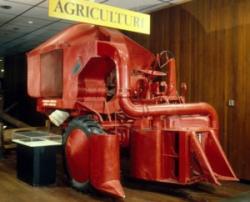Eli Whitney’s cotton gin, which at the start of the 19th century made large-scale cotton growing profitable, pumped new life into the fading institution of slavery, ensuring that something much like slavery would last long after the Civil War. It would take another century for American ingenuity to finally rid the world of the need for hand picking cotton.
Rust, John
YearAdded:
Image Credit:
Image Caption:
Era_date_from:

"The development of the cotton picker was the most important single factor which enabled the American cotton industry to stay alive," observed Dr. George S. Buck, Jr., director of research for the National Cotton Council recenty.
Some 96% of the 1969 U.S. cotton crop was harvested by machines, points out J.W. Wegener, manager of International Harvester's Memphis Works manager.
"Old Red" was built by International Harvester in 1943, retired in 1959, and restored in 1964.
YearAdded:
Image Credit:
Photo Courtesy of ASABE
Image Caption:
"Old Red" now resides in the National Museum of History & Technology, Smithsonian Institution, Washington, DC.
Era_date_from:
1943
1978

"The development of the cotton picker was the most important single factor which enabled the American cotton industry to stay alive," observed Dr. George S. Buck, Jr., director of research for the National Cotton Council recenty.
Some 96% of the 1969 U.S. cotton crop was harvested by machines,… Read More
Fall 2010 | Volume 25, Issue 3
Eli Whitney’s cotton gin, which at the start of the 19th century made large-scale cotton growing profitable, pumped new life into the fading institution of slavery, ensuring that something much like slavery would last long after the Civil War. It would take another century for American ingenuity to…


